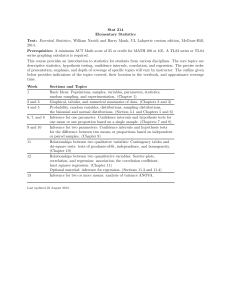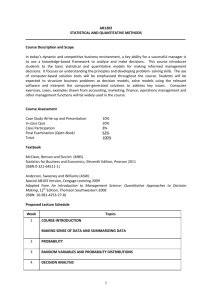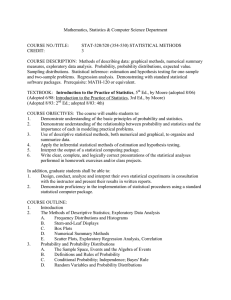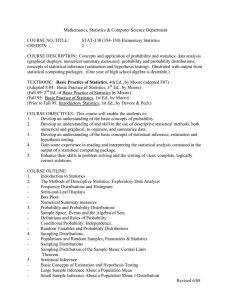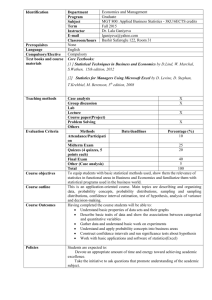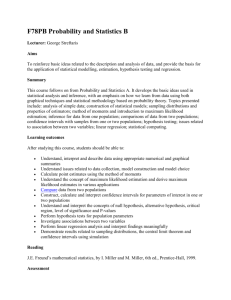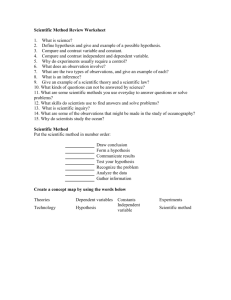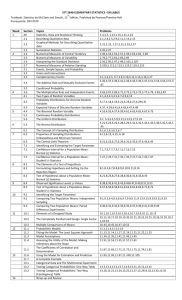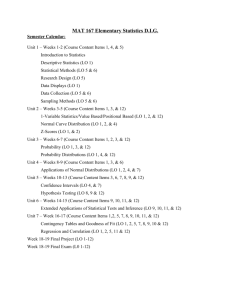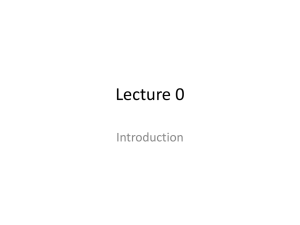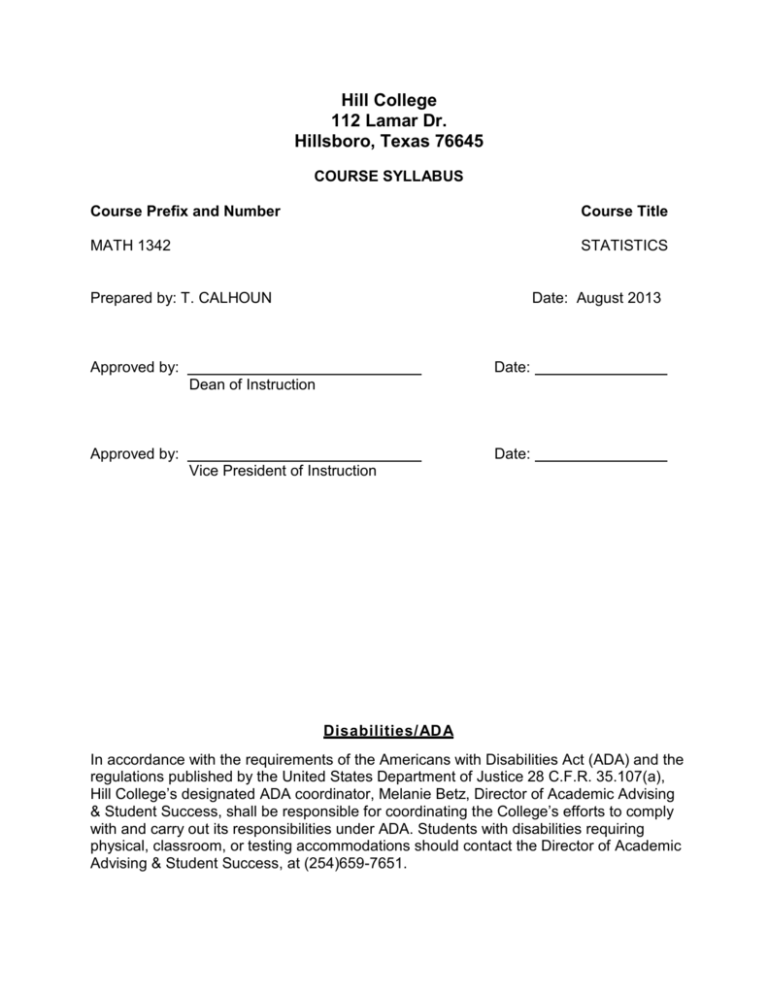
Hill College
112 Lamar Dr.
Hillsboro, Texas 76645
COURSE SYLLABUS
Course Prefix and Number
Course Title
MATH 1342
STATISTICS
Prepared by: T. CALHOUN
Date: August 2013
Approved by:
Date:
Dean of Instruction
Approved by:
Date:
Vice President of Instruction
D i s a b i l i t i e s / AD A
In accordance with the requirements of the Americans with Disabilities Act (ADA) and the
regulations published by the United States Department of Justice 28 C.F.R. 35.107(a),
Hill College’s designated ADA coordinator, Melanie Betz, Director of Academic Advising
& Student Success, shall be responsible for coordinating the College’s efforts to comply
with and carry out its responsibilities under ADA. Students with disabilities requiring
physical, classroom, or testing accommodations should contact the Director of Academic
Advising & Student Success, at (254)659-7651.
Course Description: MATH 1342
Collection, analysis, presentation, and interpretation of data and probability. Analysis
includes descriptive statistics, correlation and regression, confidence intervals and
hypothesis testing. Use of appropriate technology is recommended.
Lecture Hours
3
Lab Hours
0
Semester Credit Hours
3
Prerequisites: None
Introduction and Purpose
This course provides a one-semester general course in introductory statistics. To
exemplify the broad applications of both descriptive statistics and statistical inference,
illustrations will be drawn from the social sciences, agriculture, medicine, ecology, law
enforcement, and other areas.
Instructional Materials
Textbook: Fundamentals of Statistics (4th. ed.); Sullivan; Prentice Hall.
Supplies: Notebook paper, graph paper, ruler, and graphing calculator.
Objectives/Student Learning Outcomes
At the completion of this course the student should be able to:
1. Explain the use of data collection and statistics as tools to reach reasonable
conclusions.
2. Recognize, examine and interpret the basic principles of describing and presenting
data.
3. Compute and interpret empirical and theoretical probabilities using the rules of
probabilities and combinatorics.
4. Explain the role of probability in statistics.
5. Examine, analyze and compare various sampling distributions for both discrete and
continuous random variables.
6. Describe and compute confidence intervals.
7. Solve linear regression and correlation problems.
8. Perform hypothesis testing using statistical methods.
The students' success in completing these objectives will be measured using a set of
examinations and assignments described, in detail under the section of this syllabus
headed “Method of Evaluation”.
Methods of Instruction
This course will be taught face-to-face and by various distance learning delivery methods.
Audio-visual materials and computer-based technology will be used when appropriate.
Students will be shown how to use a calculator where appropriate.
Method of Evaluation
Grades in this course will be based on the following evaluative criteria:
Major tests will be given. They will comprise 75% of the semester grade.
A comprehensive final examination will be given. It will comprise 25% of the semester
grade. Semester grades will be based on the following values:
90-100%
80-89%
70-79%
60-69%
Below 60%
A
B
C
D
F
Class Policies:
Regular attendance at all class meetings is expected. Disruptions in class will not be
tolerated.
Topic Outline:
PART I. GETTING THE INFORMATION YOU NEED
1. Data Collection
1.1 Introduction to the Practice of Statistics
1.2 Observational Studies and Experiments
1.3 Simple Random Sampling
1.4 Other Effective Sampling Methods
1.5 Bias in Sampling
1.6 The Design of Experiments
PART II: DESCRIPTIVE STATISTICS
2. Creating Tables and Drawing Pictures of Data
2.1 Organizing Qualitative Data
2.2 Organizing Quantitative Data
2.3 Graphical Misrepresentations of Data
3. Numerically Summarizing Data
3.1 Measures of Central Tendency
3.2 Measures of Dispersion
3.3 Measures of Central Tendency and Dispersion from Grouped Data
3.4 Measures of Position and Outliers
3.5 The Five-Number Summary and Boxplots
4. Describing the Relation Between Two Variables
4.1 Scatter Diagrams and Correlation
4.2 Least-Squares Regression
4.3 The Coefficient of Determination
4.4 Contingency Tables and Association
PART III: PROBABILITY AND PROBABILITY DISTRIBUTIONS
5. Probability
5.1 Probability Rules
5.2 The Addition Rule and Complements
5.3 Independence and the Multiplication Rule
5.4 Conditional Probability and the General Multiplication Rule
5.5 Counting Techniques
5.6 Putting It Together: Probability
6. Discrete Probability Distributions
6.1 Discrete Random Variables
6.2 The Binomial Probability Distribution
7. The Normal Probability Distribution
7.1 Properties of the Normal Distribution
7.2 Applications of the Normal Distribution
7.3 Assessing Normality
7.4 The Normal Approximation to the Binomial Probability Distribution
PART IV: INFERENCE–FROM SAMPLES TO POPULATION
8. Sampling Distributions
8.1 Distribution of the Sample Mean
8.2 Distribution of the Sample Proportion
9. Estimating the Value of a Parameter (Confidence Intervals)
9.1 Estimating a Population Proportion
9.2 Estimating a Population Mean Deviation is Unknown
9.3 Putting It Together: Which Method Do I Use?
10. Hypothesis Tests Regarding a Parameter
10.1 The Language of Hypothesis Testing
10.2 Hypothesis Tests for a Population Proportion
10.3 Hypothesis Tests for a Population Mean
10.4 Putting It Together: Which Method Do I Use?
11. Inference on Two Samples
11.1 Inference about Two Proportions
11.2 Inference about Two Means: Dependent Samples
11.3 Inference about Two Means: Independent Samples
11.4 Putting It Together: Which Method Do I Use?
12. Additional Inferential Procedures
12.1 Goodness of Fit Test
12.2 Tests for Independence and the Homogeneity of Proportions
12.3 Testing the Significance of the Least-Squares Regression Model
12.4 Confidence and Prediction Intervals
Bibliography
Sullivan, Michael III, Fundamentals of Statistics Informed Decisions Using Data (4th. ed.);
Pearson/Prentice Hall, 2014, 2011, 2008

